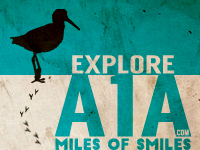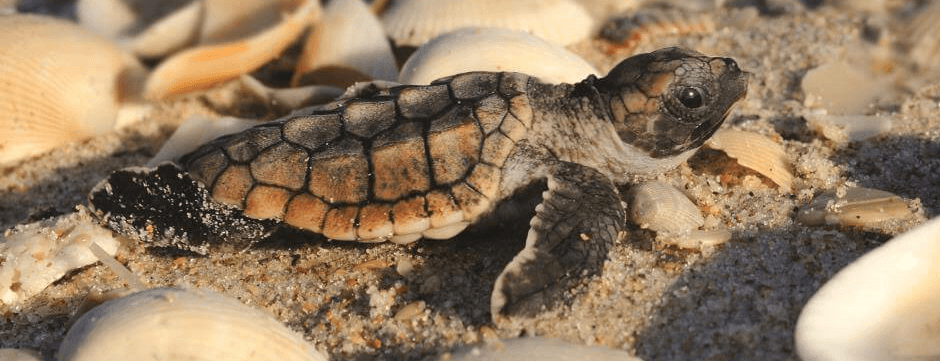Much can be learned about the condition of the planet’s environment by looking at sea turtles. Sea turtles travel throughout the world’s oceans and have existed for over 100 million years. Suddenly however, they are struggling to survive — largely because of the things we humans are doing to the planet’s oceans and beaches. So what does this all mean for us?
It is possible that a world in which sea turtles cannot survive may soon become a world in which humans struggle to survive. If however, we learn from our mistakes and begin changing our behavior, there is still time to save sea turtles from extinction. And in the process of saving one of the earth’s most mysterious and time-honored creatures, we might just be saving ourselves too.
In an effort to effect lasting change far greater than we could accomplish on our own, we are partnering with Sea Turtle Conservancy, the world’s oldest and most accomplished sea turtle research and conservation organization, to help raise both the awareness and the funds to support the ongoing educational programs and outreach efforts that continue to make a measurable difference.
Yes, we love the freedom to explore AND we believe there’s a responsibility that goes along with it. As we enthusiastically encourage our global community of A1A Explorers to eat, beach, sleep, and play along our magnificent Atlantic coast, we hope you’ll choose to join us and support the extraordinary work of Sea Turtle Conservancy.
Use the following links to learn more about the Sea Turtle Conservancy or make a donation now!
Good to Know…
 From Sea Turtle Conservancy (conserveturtles.org) we learned that unlike baby alligators, which are freed from their nest by their mother, sea turtle hatchlings must do it all themselves. To break open their shells, hatchlings use a temporary, sharp egg-tooth, called a “caruncle.” The caruncle is an extension of the upper jaw that falls off soon after birth. Digging out of the nest is a group effort that can take several days and once they decide to burst out, they erupt from the nest cavity as a group. The little turtles orient themselves to the brightest horizon, and then dash toward the sea. The obstacles are so numerous for baby turtles that only about one in 1,000 survives to adulthood. With nesting season once again upon us, remember it’s illegal to harm, harass or take sea turtles, their eggs and hatchlings, including getting too close to a nesting female and if you see anyone doing it, here’s the number for the FWC’s Wildlife Alert Hotline 888-404-3922 please take a minute now to add it to your cell. We took this pic on fabulous Fat Deer Key and thought it was a great illustration of the visual clues loggerheads and green turtles leave to alert us that nesting activity may be nearby.
From Sea Turtle Conservancy (conserveturtles.org) we learned that unlike baby alligators, which are freed from their nest by their mother, sea turtle hatchlings must do it all themselves. To break open their shells, hatchlings use a temporary, sharp egg-tooth, called a “caruncle.” The caruncle is an extension of the upper jaw that falls off soon after birth. Digging out of the nest is a group effort that can take several days and once they decide to burst out, they erupt from the nest cavity as a group. The little turtles orient themselves to the brightest horizon, and then dash toward the sea. The obstacles are so numerous for baby turtles that only about one in 1,000 survives to adulthood. With nesting season once again upon us, remember it’s illegal to harm, harass or take sea turtles, their eggs and hatchlings, including getting too close to a nesting female and if you see anyone doing it, here’s the number for the FWC’s Wildlife Alert Hotline 888-404-3922 please take a minute now to add it to your cell. We took this pic on fabulous Fat Deer Key and thought it was a great illustration of the visual clues loggerheads and green turtles leave to alert us that nesting activity may be nearby.
WHERE ARE THE STRAWS?
Sea Turtle Conservancy is challenging restaurants to adopt a new policy: only offering straws upon request.
The Ocean Conservancy created the successful “Skip the Straw” campaign and is currently working with Chiles Restaurant Group in Anna Maria Island to adopt this policy. STC has expanded the idea by creating a 5 x 7 sign that restaurants can use that explains why there are no straws available, how straws impact wildlife, and where to find more information about marine debris. This sign can be displayed on menus or near self-serve drink stations, where the straws would normally be offered.
Giving up straws is a small but incredibly impactful way to help save wildlife. Americans use more than 500 million straws daily, and they cannot be recycled, leading them to sit in landfills or end up in digestive systems of birds and other wildlife. On the coasts, plastics are already negatively affecting more than 660 marine wildlife species. Sea turtles are especially impacted by plastic waste.
Like humans, a sea turtle’s mouth cavity is connected to its nasal cavity; as it has occurred before, if accidentally ingested, a straw may become lodged into the turtle’s nose. Not only does this lead to direct complications such as prevention of proper breathing and sense of smell—a turtle’s primary method to locate food—but it can also cause complications with migration and the ability to find a mate.
Forgoing straws doesn’t just help wildlife – it helps people, too. Restaurants that choose to adopt this policy will spend less money on ordering straws, because they will not use as many. Customers also enjoy supporting environmentally-conscious businesses, so adopting this policy may encourage more customers to come to a restaurant. Humans depend on the ocean for food, recreation, and economic benefit. If the ocean is filled with plastic, humans will suffer as well as marine wildlife.
Restaurants in Gainesville (where STC is based) have already begun to embrace this policy. STC believes this campaign will be even more successful at restaurants along A1A, where straws can undeniably end up in critical sea turtle nesting habitat.

If a restaurant is interested in adopting this policy, wants a customized sign or wants more information about this initiative, please contact [email protected].

